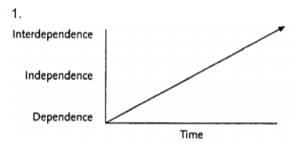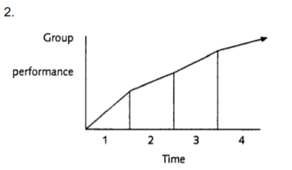Group development
A group is any number of people doing something together.
This is normally working together, whether formally or informally, but it might also be playing together or just being together socially. A group could consist of two people or twenty people. Experience suggests that somewhere between five and eight people is the natural size of a group. A large group tends to break up quite naturally into smaller groups.
Being a member of a group is valuable to us. Through group relationships we satisfy many needs such as companionship, status, and power. We also develop social roles and relationships. Studies have shown that where groups at work are constantly broken up satisfaction is lowered and people leave organisations. Where care is taken to form and maintain appropriate groups, satisfaction and output are greater.

However, the time taken at each stage is not easily measured.
Where people are drawn into one another's company, as in Scouting, relationships develop, common group attitudes are formed, and norms of behaviour begin to emerge. It may be important for all members to behave in certain way because of their common aims and the need for solidarity. Norms of behaviour may develop which identify the group as distinctive from others: convention dress, distinctive slang, mannerisms, etc.
Group growth
Any group coming together will go through a definite pattern of behaviour. Its growth from dependence to interdependence through time can be simply explained thus:

1. Forming
Group Structure
There is anxiety; dependence on a Leader; testing to find out the nature of the situation and what behaviour is acceptable.
Task Activity
Members find out what the task is; what the values are, what methods are appropriate.
2. Storming
Group Structure
Conflict between subgroups; rebellion against leader, opinions are polarised resistance to control by group; conflicts over intimacy
Task Activity
Emotional resistance to demands of the task.
3. Norming
Group Structure
Development of group cohesion; norms emerge; resistance overcome; conflicts patched up; mutual support and development of group feelings.
Task Activity
Open exchange of views and feelings; cooperation develops.
4. Performing
Group Structure
Interpersonal problems are resolved; interpersonal structure is the tool of the task; activity; roles are flexible and functional.
Task Activity
Emergence of solutions to problems; constructive attempts at task completion, energy is now available for effective work; this is a major work period.
- The atmosphere which can be sensed in a few minutes of observation tends to be comfortable. There are no obvious tensions.
- It has a working climate in which people are involved and interested.
- There is a lot of discussion in which everyone participates, but it remains pertinent to the task of the group.
- The task of the group is well understood and accepted by all members.
- The members listen to each other. People are not afraid of putting forward a creative idea, even though it seems fairly extreme.
- If there is a disagreement the group is comfortable with this. They show no signs of having to avoid conflict, but work to accept it.
- There is no tyranny of the minority. Individuals who disagree do not appear to be trying to dominate the group.
- When there are disagreements which cannot be resolved the group finds it possible to live with them, accepting them but not permitting them to block their efforts.
- Most decisions are reached by a kind of consensus in which it is clear that everybody is in general agreement and willing to go along.
- Criticism is frequent, frank, and relatively comfortable. People feel free to express their feelings.
- When action is taken clear assignments are made and accepted.
- The chairperson of the group does not dominate it, nor does the group refer unduly to the chair.
- There is little evidence of a struggle for power.
- The group will frequently stop to examine how well it is doing and tackle the problems that are interfering with its operation
- The atmosphere is likely to reflect either indifference or boredom.
- A few people tend to dominate discussions, others may opt out and remain silent.
- From the things that are said it is difficult to understand what the task is or what the objectives are.
- People do not listen to each other
- Conversation with members after the meeting will reveal that they have failed to express their feelings
- Disagreements are not dealt with, they may be suppressed by the leader who fears conflict
- There is a tyranny of the minority in which an individual or a small subgroup is so aggressive that the majority accedes to their wishes.
- Actions are often taken prematurely before the real issues are resolved.
- Actions and decisions are unclear. No one really knows what is going on.
- Criticisms may be present, but they are embarrassing and produce tension
- Personal feelings are hidden rather than brought out in the open.
- The group often avoids any discussions of its own maintenance. There is often much discussion after the meeting of what went wrong and why.
- The leader ensures that all members of the group understand their task
- The need for the given task is agreed by all members. The objectives for the group's work are agreed by all members.
- The group uses and builds on the strengths and skills of all concerned.
- All contributions from individuals are directed towards one person. This ensures that only one person speaks at any one time and therefore all are able to listen. Because of this all contributions are valued.
- The group evaluates or reviews its work in order that it can become more effective when working on its next task.